Why Group Decisions Fail (And How the Right Tools Can Help)
Team decision-making is fraught with challenges. From the loudest voice dominating the conversation to pervasive groupthink and analysis paralysis, making a clear, collective choice can feel impossible. These common pitfalls lead to weak strategies, disengaged team members, and stalled projects. The root of these issues often lies in unstructured communication. Understanding how to foster a more transparent and effective dialogue is a critical first step; for more on this, you can review these internal communication best practices to help avoid common team dysfunctions.
This is where dedicated collaborative decision making tools come in. They are not just chat apps or project boards; they are structured environments designed to foster inclusivity, clarity, and focus. These platforms provide frameworks that ensure all ideas are heard, options are evaluated fairly, and outcomes are transparent and well-documented.
This article will guide you through the 12 best tools available, offering a detailed analysis of their unique strengths and ideal use cases. We'll explore practical implementation scenarios and honest limitations to help you find the perfect fit for your team’s specific needs.
1. Bulby
Bulby is an innovative brainstorming platform specifically designed to empower remote and distributed teams. It distinguishes itself from other collaborative decision making tools by combining AI-powered guidance with structured, research-backed exercises. This unique methodology actively facilitates sessions, helping teams navigate past common cognitive biases and creative blocks. The result is a more inclusive environment where diverse thinking thrives, ensuring every team member's voice is heard and valued.
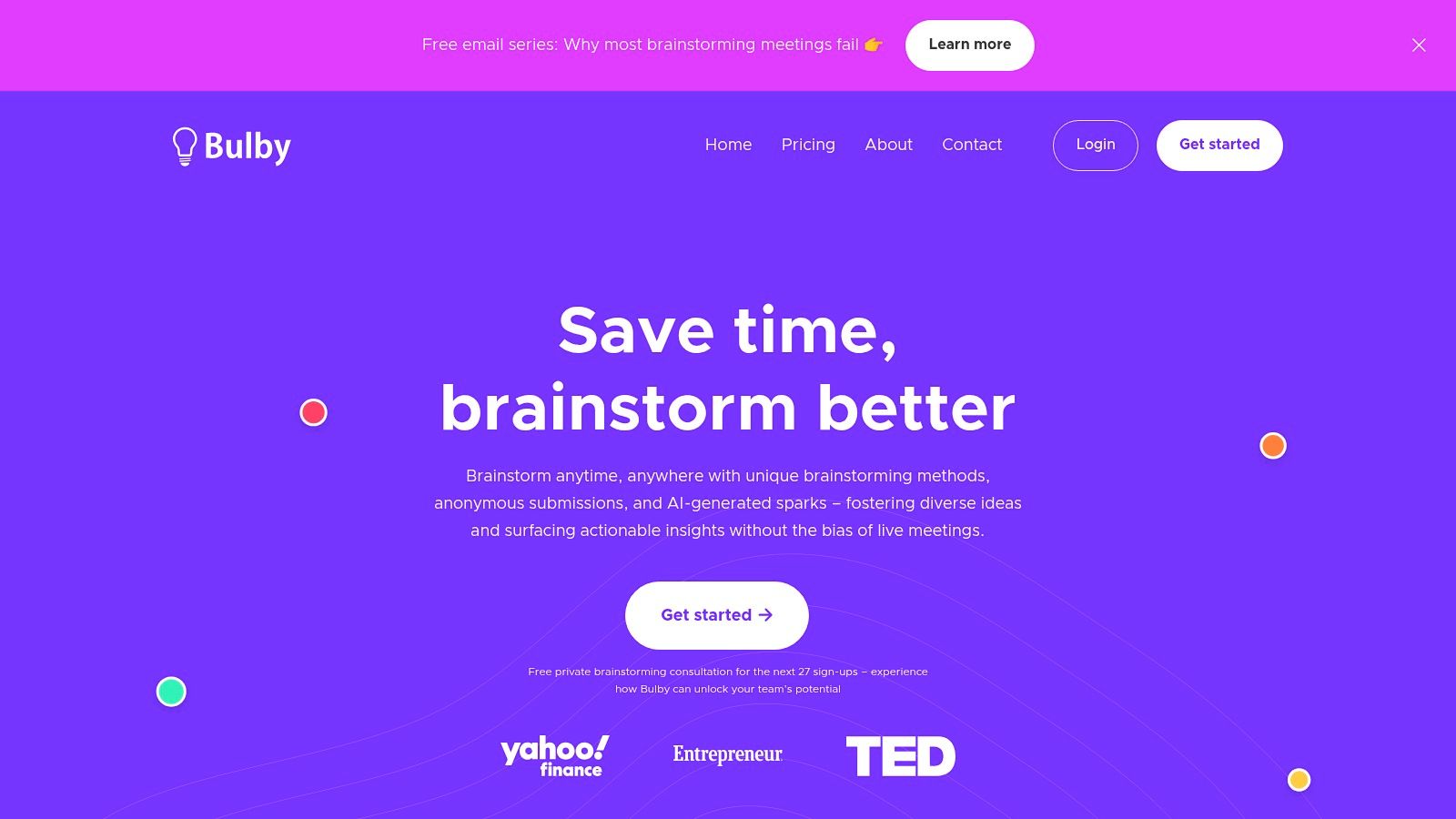
Practical Use and Implementation
In practice, a product team could use Bulby to systematically explore and prioritize new features, while a marketing department might use it to develop a complex campaign concept. Its guided structure also makes it highly effective for university innovation programs or student entrepreneurs needing to validate ideas. Implementation is simple, as the AI serves as a built-in facilitator. Bulby excels at turning abstract ideas into concrete action items. A key part of this transition is ensuring the subsequent workflow is efficient. For technical teams, understanding code merge best practices is essential for maintaining quality and momentum after a decision is made.
Key Considerations
Pros:
- AI-powered guidance keeps sessions focused and productive.
- Research-backed exercises are tailored for remote team challenges.
- Encourages diverse thinking to overcome bias.
- Seamlessly converts ideas into actionable next steps.
Cons:
- Pricing is not public and requires direct contact.
- Primarily optimized for remote teams, less so for in-person collaboration.
Pricing
Contact Bulby directly for pricing information.
Website: bulby.com
2. Miro
Miro is an expansive digital whiteboard platform that serves as a central hub for visual collaboration. It empowers teams to brainstorm, plan, and execute projects on an infinite canvas, making it one of the most flexible collaborative decision making tools available. Its strength lies in translating complex discussions and workflows into clear, shared visual maps that everyone can interact with in real time, fostering a shared understanding from start to finish.
Practical Use and Implementation
In a practical setting, an agile team can use Miro for sprint planning and retrospectives, while a design team can create detailed user journey maps. Its vast template library streamlines workshops for design thinking or strategic planning. Implementation is straightforward due to its intuitive interface and deep integrations with tools like Jira and Slack. This connectivity allows teams to turn visual decisions on the board directly into actionable tickets and project updates, ensuring a seamless workflow.
Key Considerations
Pros:
- User-friendly interface that is highly intuitive for new users.
- Supports both synchronous and asynchronous collaboration effectively.
- Highly customizable with a massive template library for diverse needs.
- Robust integration capabilities with popular project management tools.
Cons:
- Functionality is limited when working offline.
- Boards can become cluttered and slow with extensive use by large teams.
Pricing
Miro offers several pricing tiers, including a free plan with core features suitable for small teams. Paid plans (Starter, Business, and Enterprise) unlock advanced functionalities like unlimited boards, private projects, and enhanced security controls.
Website: miro.com
3. Asana
Asana is a well-established project management platform that excels at turning collaborative decisions into structured, trackable action. While known for task management, its strength as one of the top collaborative decision making tools lies in its ability to centralize communication, assign ownership, and provide clear visibility into progress post-decision. Its multiple project views allow teams to visualize workflows in a way that best suits their process, from Kanban boards for agile sprints to timelines for long-term strategic planning.
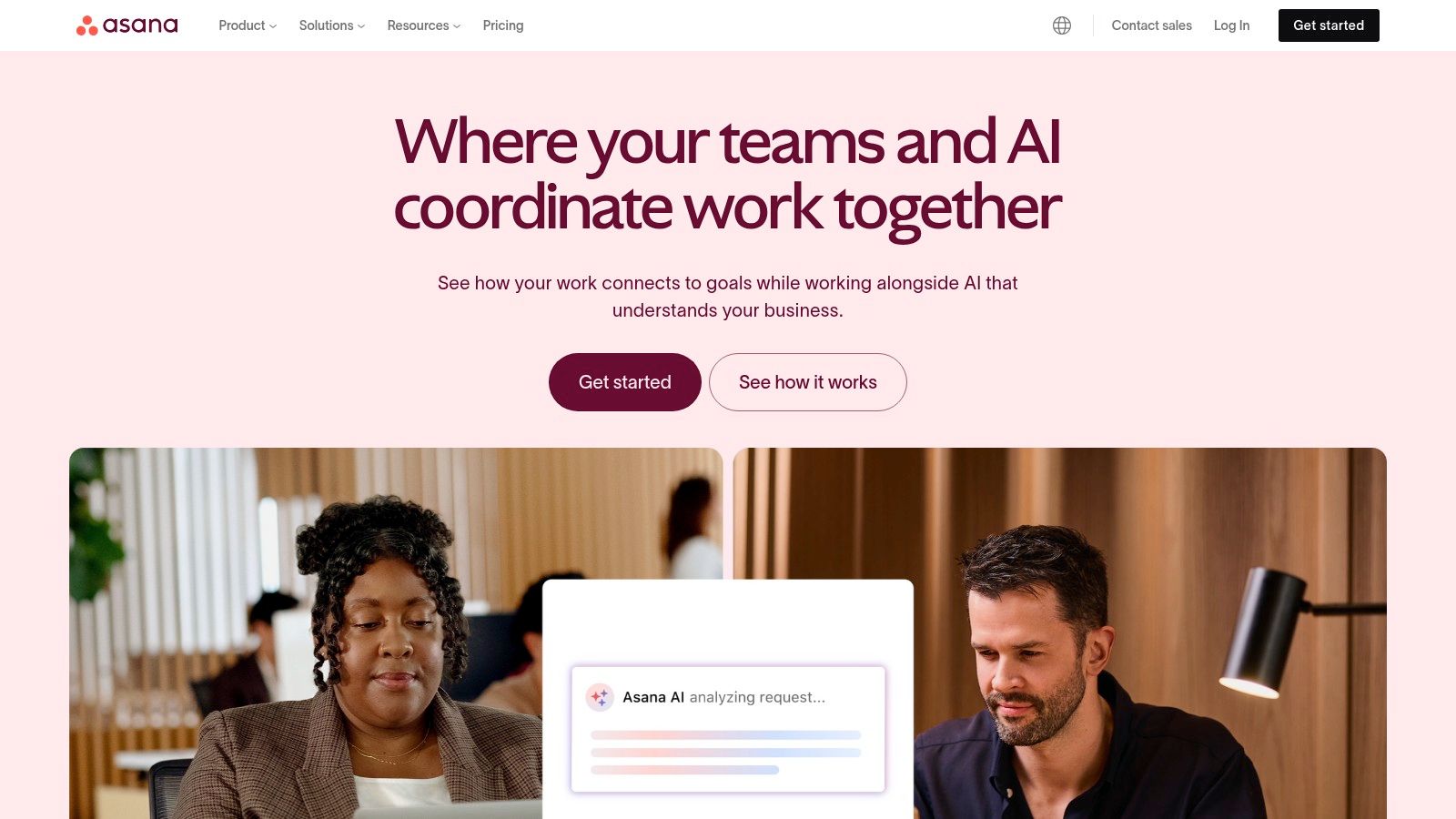
Practical Use and Implementation
In practice, a team can create a project in Asana dedicated to a specific decision, like "Select New CRM Vendor." Each potential vendor becomes a task, where team members can comment, attach research, and use custom fields to score options. Once a choice is made, the project seamlessly transitions into an implementation plan. This makes it an essential piece of remote team management software for maintaining momentum. Automations can then trigger next steps, such as assigning tasks to the IT department for integration.
Key Considerations
Pros:
- Intuitive interface with a gentle learning curve for new users.
- Highly customizable with custom fields, rules, and templates.
- Strong integration ecosystem connects with tools like Slack and Google Drive.
- Provides clarity by linking tasks to overarching company goals.
Cons:
- Advanced features like Portfolios and Goals are gated in higher-tier plans.
- Can feel overly complex for individuals or teams with very simple projects.
Pricing
Asana offers a free Basic plan for individuals or small teams. Paid plans include Premium, starting at $10.99 per user/month, and Business, starting at $24.99 per user/month, which unlock more advanced features.
Website: asana.com
4. Trello
Trello is a visual Kanban-style board system that simplifies project and task management for teams. While often seen as a task tracker, its strength as one of the most accessible collaborative decision making tools lies in its visual clarity. Teams can map out options, track progress on initiatives, and centralize discussions, making it easy to see where a decision stands at a glance. Its intuitive interface allows everyone, from university students to product managers, to get started quickly.
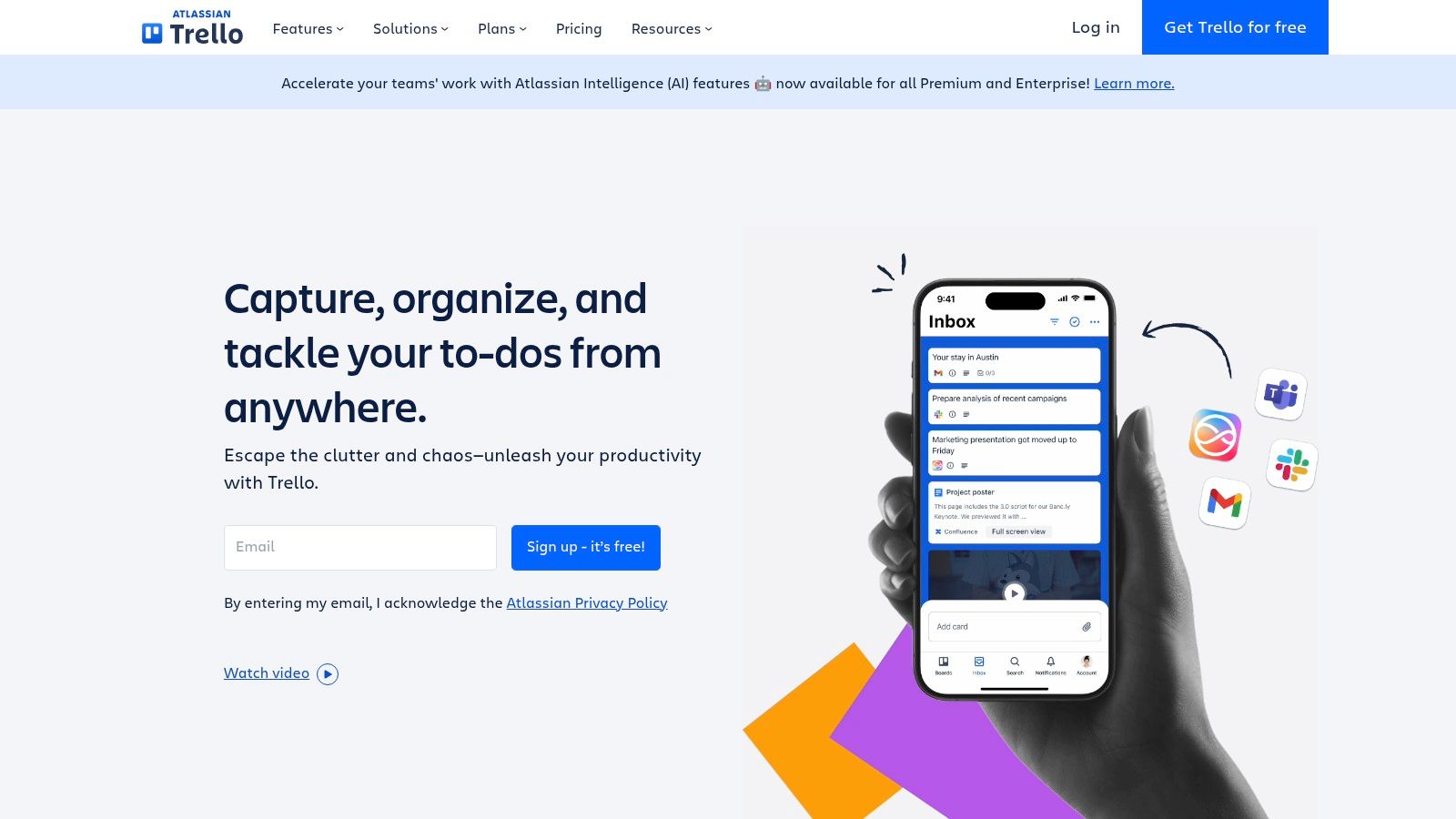
Practical Use and Implementation
In practice, a team can use a Trello board to manage a feature backlog, moving cards from an "Ideas" list to "In Discussion" and finally to "Approved" to document the decision lifecycle. Each card can host debates via comments, hold attachments like mockups, and use checklists to outline approval criteria. Implementation is straightforward: create a board, invite members, and start adding cards. Its Butler automation can be configured to automatically notify stakeholders when a card moves to a new decision stage, ensuring everyone stays informed.
Key Considerations
Pros:
- Extremely easy to set up and use with minimal training.
- Highly visual and intuitive drag-and-drop interface.
- Flexible enough to be adapted for various project types.
- Power-Ups add powerful integrations and features like calendars.
Cons:
- Reporting and analytics features are limited on lower-tier plans.
- May lack the depth needed for highly complex project management.
Pricing
Trello offers a free plan with core features. Paid plans (Standard, Premium, and Enterprise) unlock advanced features like unlimited boards, advanced checklists, and more automation.
Website: trello.com
5. Monday.com
Monday.com is a comprehensive work operating system (Work OS) that empowers teams to manage projects, build custom workflows, and collaborate seamlessly. It functions as one of the most versatile collaborative decision making tools by centralizing communication and data in a highly visual environment. This structure allows teams to track progress against goals in real-time, making it easier to identify bottlenecks and make informed choices based on a shared source of truth.
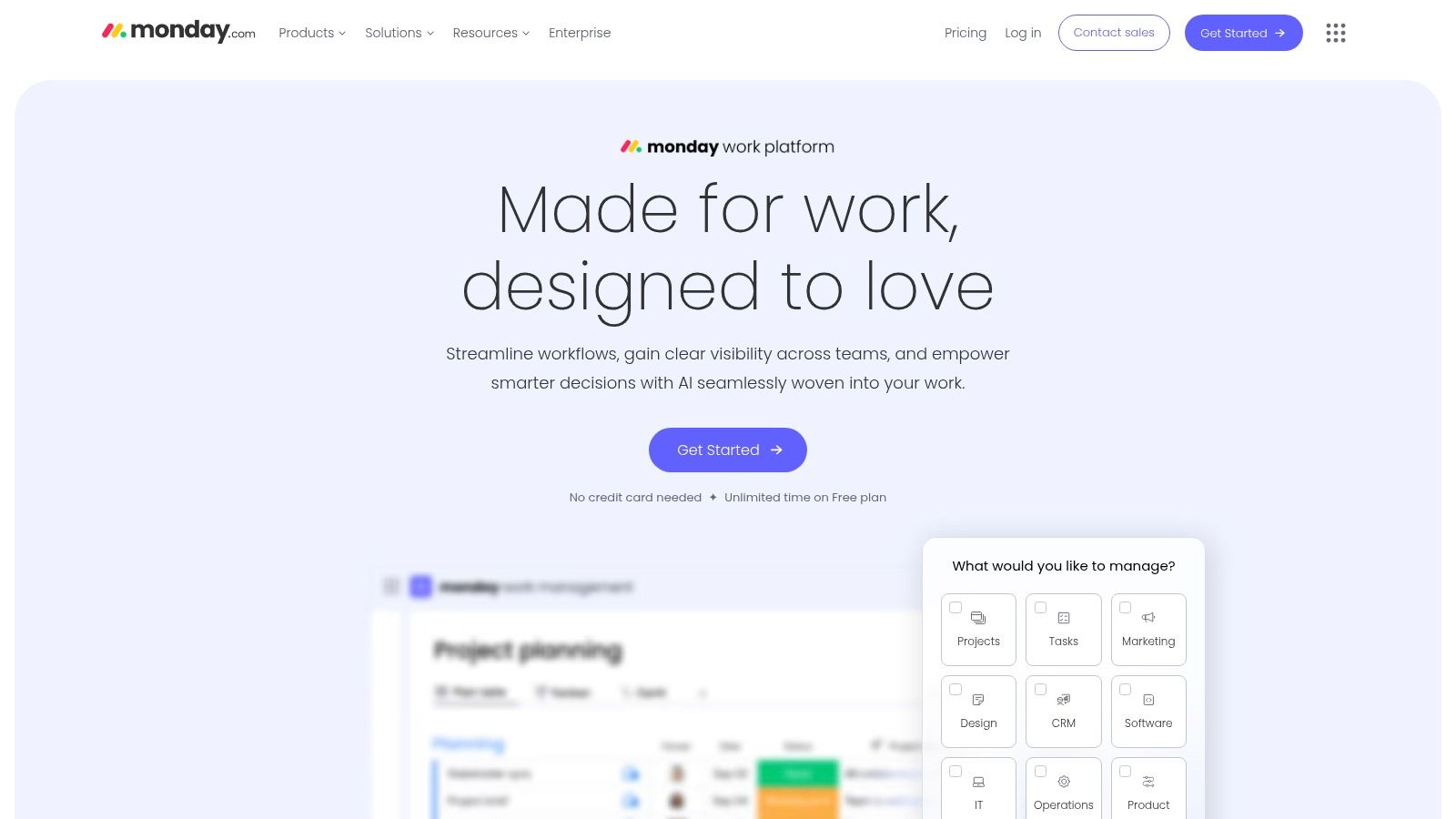
Practical Use and Implementation
In practice, a marketing team could use Monday.com's Kanban view to manage a content calendar, with each card representing a task whose status update is visible to all stakeholders. Automations can be set to notify a manager when a task moves to "Needs Review," streamlining the approval process. Implementation involves choosing from various templates and then customizing columns, views, and automations to match a team's specific decision-making framework. This initial setup is crucial for maximizing the platform's utility.
Key Considerations
Pros:
- Highly customizable to fit diverse team needs.
- User-friendly interface with strong visual appeal.
- Strong automation capabilities to streamline workflows.
Cons:
- Pricing can be high for small teams or startups.
- Initial setup may require significant time to tailor workflows perfectly.
Pricing
Monday.com offers several pricing tiers, including a free plan for individuals, with paid plans (Basic, Standard, Pro, and Enterprise) scaling by features and team size.
Website: monday.com
6. Microsoft Teams
Microsoft Teams is a unified communication platform that serves as the collaboration hub for organizations invested in the Microsoft 365 ecosystem. It combines persistent chat, video meetings, file storage, and deep application integration into a single workspace. This centralizes communication, making it one of the most widely adopted collaborative decision making tools for businesses of all sizes. Its strength lies in keeping conversations, documents, and meetings organized within specific team channels.
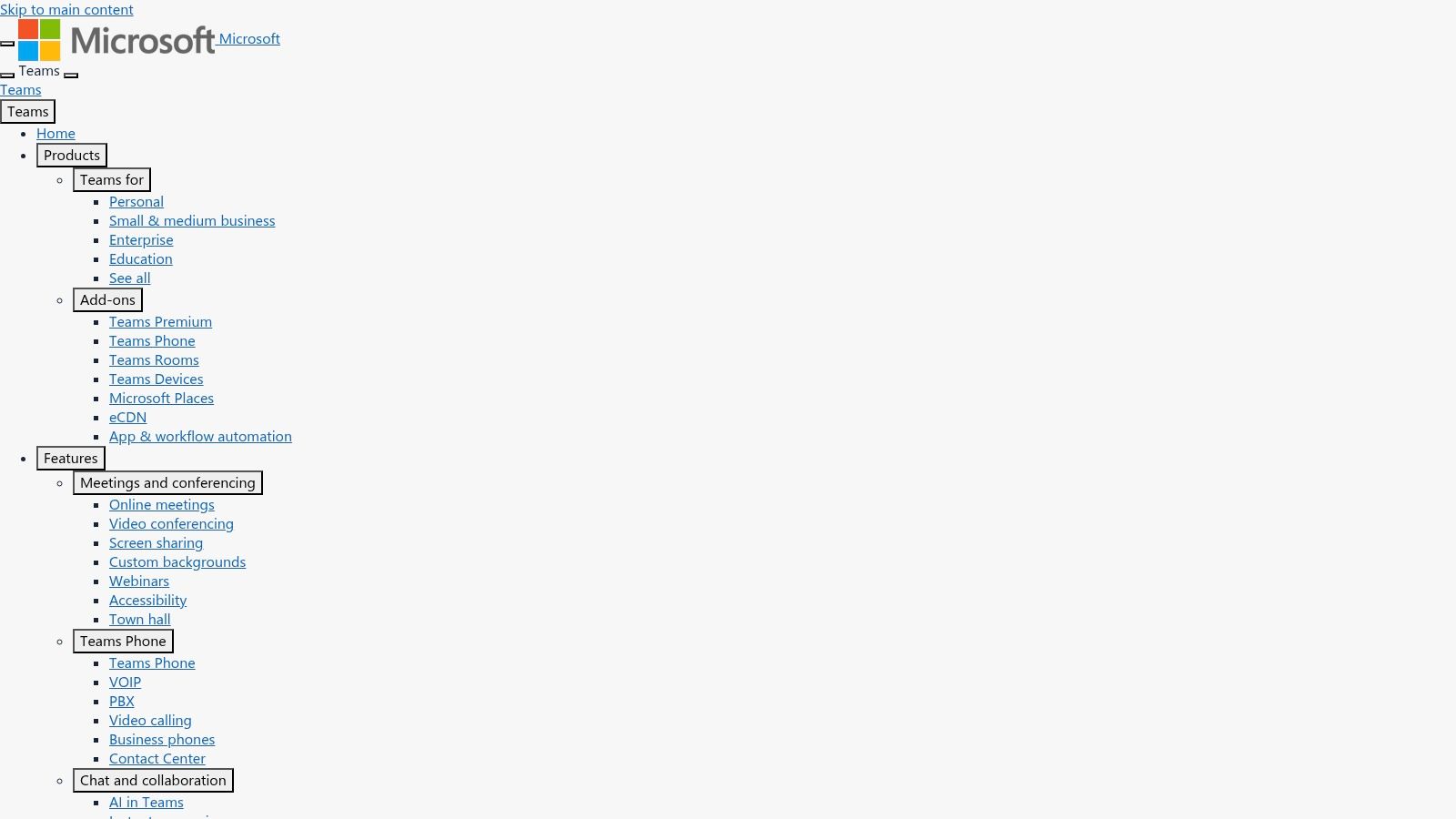
Practical Use and Implementation
In practice, a project team can create a dedicated channel to discuss a new initiative, co-author a project proposal in a shared Word document, and hold video calls to finalize details without ever leaving the app. Implementation is straightforward for companies already using Microsoft 365. The key is structuring channels logically to prevent information silos. For organizations looking to optimize group choices, it is important to understand the full scope of Microsoft Teams' collaborative decision-making capabilities to leverage its features effectively.
Key Considerations
Pros:
- Seamless integration with the entire Microsoft 365 suite.
- Robust security and compliance features suitable for enterprises.
- Supports large-scale meetings and webinars.
Cons:
- Can be resource-intensive on older hardware.
- The vast number of features may present a learning curve for new users.
Pricing
Microsoft Teams is included with Microsoft 365 Business and Enterprise subscriptions. A free version with limited features is also available.
Website: microsoft.com
7. Slack
Slack is a channel-based messaging platform that has become the central communication hub for countless organizations. While not exclusively a decision-making tool, it provides the essential foundation for the discussions that drive choices. Its structure of public channels, private groups, and direct messages allows teams to organize conversations by project, topic, or department. This segmentation makes it an indispensable asset among collaborative decision making tools, supporting both real-time brainstorming and asynchronous input from team members across different time zones.

Practical Use and Implementation
In practice, a development team can create a dedicated channel like #bug-triage to discuss, prioritize, and decide on critical fixes. Integrations with project management tools like Jira or Trello allow decisions made in Slack to be instantly converted into actionable tasks. Effective implementation also hinges on clear scheduling. While Slack integrates with calendars, teams using other ecosystems like Microsoft Teams should explore a dedicated team calendar sync to ensure everyone is aligned on post-decision timelines and meetings, preventing momentum loss.
Key Considerations
Pros:
- User-friendly interface with a minimal learning curve.
- Extensive integration capabilities connect your entire tech stack.
- Supports both real-time and asynchronous communication effectively.
- Powerful search allows you to find past decisions and context easily.
Cons:
- Constant notifications can become overwhelming without proper channel management.
- The free plan has significant limitations on message history and file storage.
Pricing
Slack provides a free tier with limitations. Paid plans like Pro and Business+ are available on a per-user, per-month basis, offering expanded features and history.
Website: slack.com
8. Notion
Notion is an all-in-one workspace that consolidates note-taking, project management, and knowledge bases into a single, highly flexible environment. It stands out among collaborative decision making tools by allowing teams to design their own systems from the ground up, using interconnected pages, databases, and boards to create a central source of truth. This customizability ensures that every part of the decision-making process, from initial research to final approval, is tracked in one place.
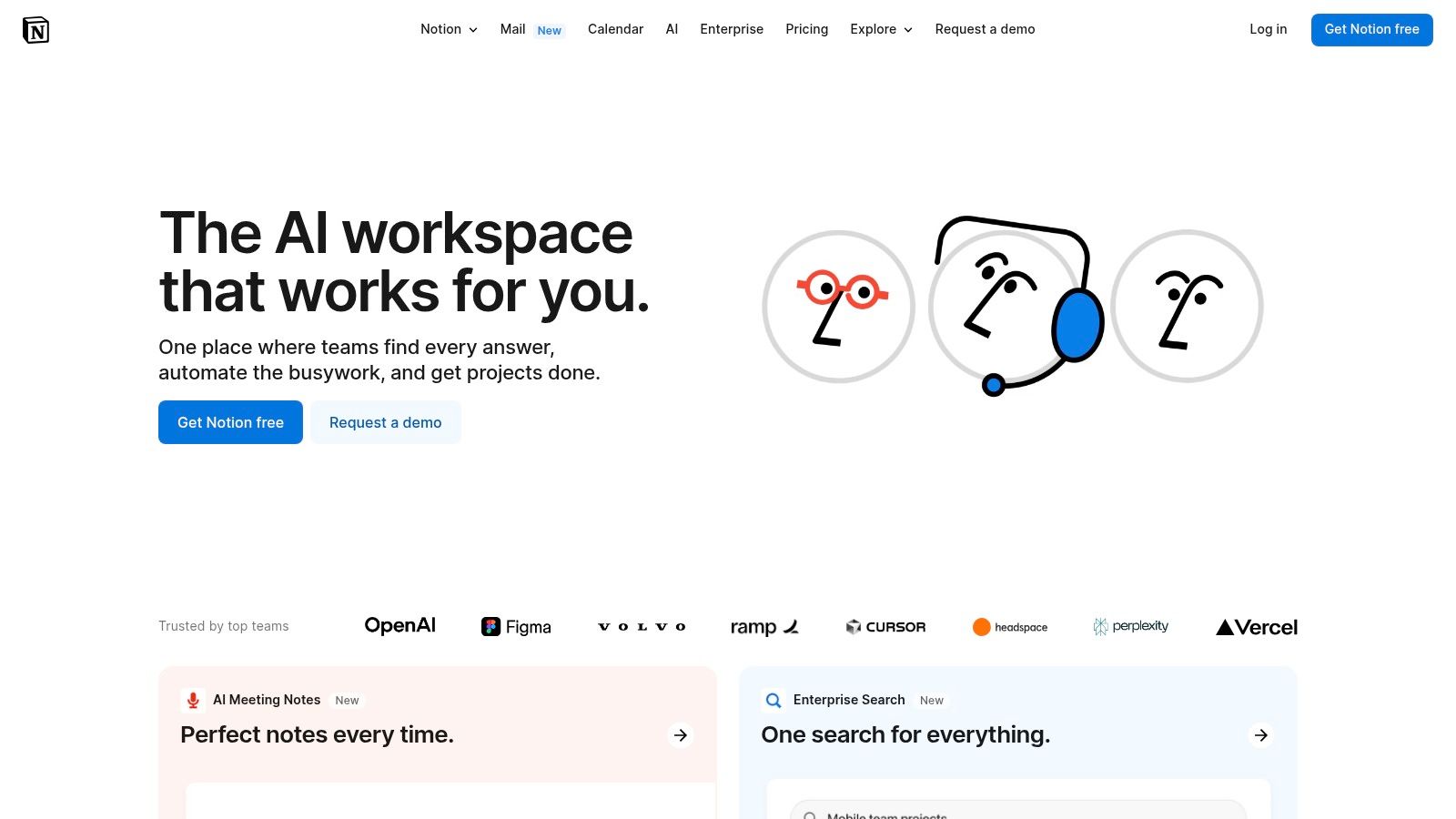
Practical Use and Implementation
In practice, a team can use a Notion database to build a comprehensive decision log, tracking proposals, stakeholders, evidence, and outcomes. For example, a marketing team could use a Kanban board to move campaign ideas through stages of approval, with each card containing all relevant creative assets and discussion threads. Implementation is most successful when a team agrees on a set of templates for common processes, ensuring consistency and making it easier for new members to contribute.
Key Considerations
Pros:
- Highly flexible and customizable to fit any team's unique workflow.
- Combines multiple tools into one unified platform, reducing context switching.
- User-friendly interface with a clean, minimalist design.
Cons:
- Can have a steep learning curve due to its vast customization options.
- Offline functionality is limited, which can hinder productivity without an internet connection.
Pricing
Notion offers a free plan for individuals. Paid tiers include Plus, Business, and Enterprise, which add features like increased collaboration, advanced permissions, version history, and dedicated support.
Website: notion.so
9. Loomio
Loomio is a decision-making software built to help groups achieve consensus through structured collaboration. It centers on transparent discussions and formal proposal processes, ensuring every participant can contribute meaningfully. Unlike broader project management platforms, Loomio's focus is purely on facilitating clear communication and democratic outcomes, making it one of the most dedicated collaborative decision making tools for groups prioritizing inclusivity.
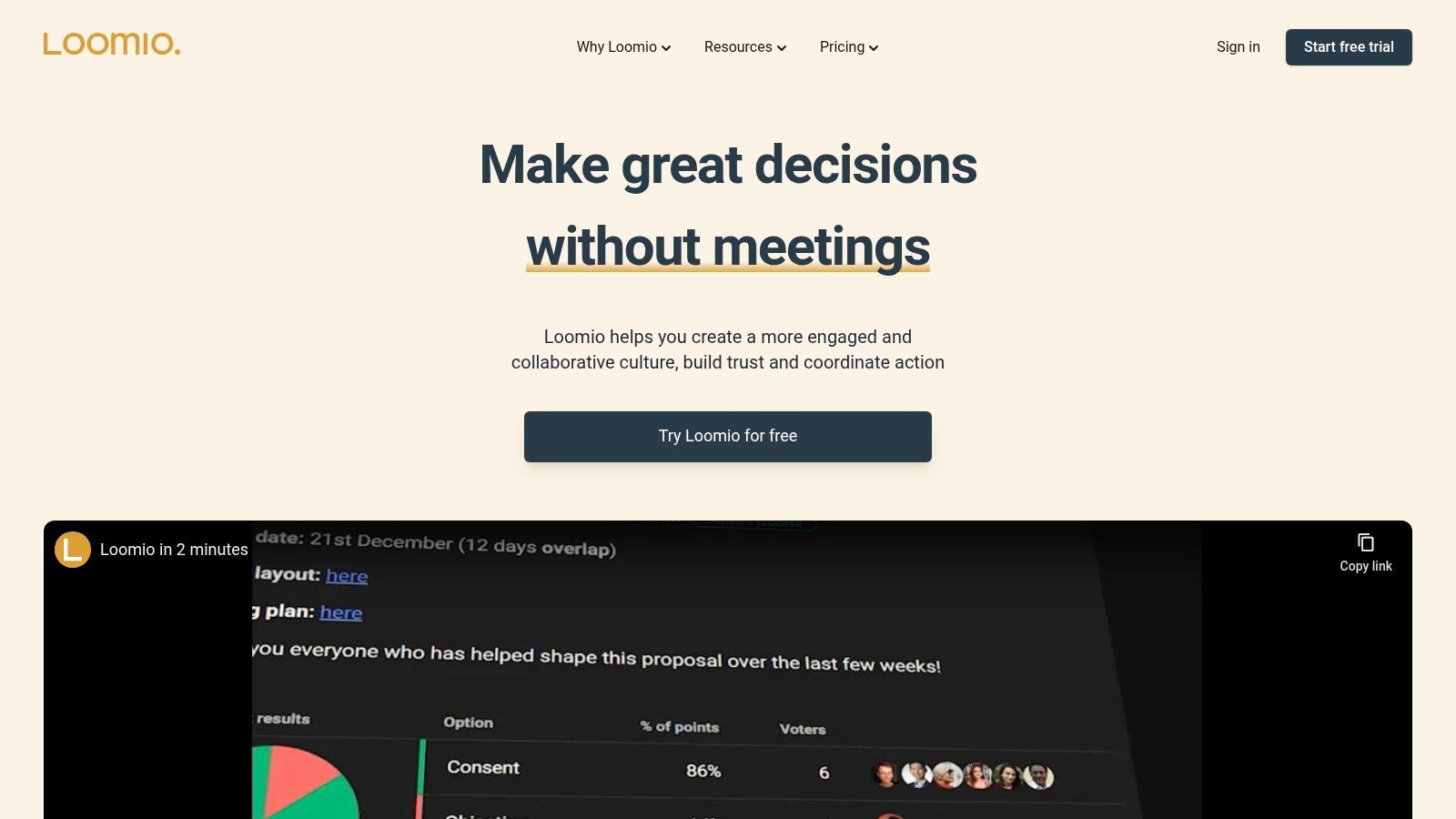
Practical Use and Implementation
A non-profit board could use Loomio to debate and vote on strategic initiatives, creating a permanent, transparent record of the decision. Similarly, a co-op or a community-led project can use it to gather member feedback on policies before putting them to a formal vote. Implementation is straightforward due to its intuitive interface and email notifications. The platform excels at keeping conversations organized in threads, preventing important points from getting lost in a noisy chat channel.
Key Considerations
Pros:
- Facilitates transparent and inclusive decision-making.
- User-friendly interface with a minimal learning curve.
- Supports various voting methods to fit different group dynamics.
- Creates a clear, auditable trail for all decisions.
Cons:
- Limited native integrations with other project management or communication tools.
- Less suited for tracking complex tasks and project execution post-decision.
Pricing
Loomio offers a free plan for public community groups. Paid plans start with Loomio Pro for individuals and small teams, with custom pricing available for larger organizations needing advanced features and support.
Website: loomio.org
10. Xmind
Xmind is a professional mind mapping and brainstorming software designed to help teams visually organize complex information. It excels at turning scattered ideas into structured diagrams, making it one of the most effective collaborative decision making tools for clarifying thought processes. With various structures like mind maps, logic charts, and fishbone diagrams, it allows teams to explore problems and solutions from multiple angles, fostering a shared understanding before a final decision is made.

Practical Use and Implementation
In a practical setting, a product team can use Xmind to map out user journeys or structure feature backlogs, while a marketing team might use a matrix diagram to compare competitor strategies. Implementation is straightforward due to its intuitive design. Teams often use it to facilitate a brainstorming session, then export the map to a PDF or image file to serve as a meeting record. The visual clarity it provides is a core benefit of brainstorming and mind mapping, ensuring all stakeholders are aligned on the outcome.
Key Considerations
Pros:
- Enhances creativity and helps organize complex ideas visually.
- User-friendly interface with an intuitive, easy-to-learn design.
- Supports complex information structuring with multiple diagram types.
- Cross-platform support allows use on desktop and mobile devices.
Cons:
- Real-time collaboration features are less advanced compared to dedicated cloud-based tools.
- Many advanced features and export options are locked behind the premium plan.
Pricing
Xmind offers a free version with essential features. Xmind Pro is available via subscription for access to advanced functionalities.
Website: xmind.net
11. Noni
Noni is a real-time decision-making platform designed for teams that prioritize clarity, structure, and fairness. It differentiates itself by guiding users through a complete, step-by-step process, moving from initial idea collection to a definitive outcome. The tool’s core strength lies in its structured methodology, which ensures every stage of the decision is transparent and participatory. By providing a clear framework, Noni helps teams avoid disorganized discussions and reach conclusions that everyone understands and can support.
Practical Use and Implementation
In practice, a leadership team could use Noni to prioritize strategic initiatives for the upcoming quarter. Each option is added, discussed, and then ranked using the platform’s signature pairwise voting system. This method, which pits every option against every other one in a series of simple head-to-head votes, removes bias and produces a mathematically clear winner. Implementation is straightforward, especially for teams on Slack, as Noni integrates directly into communication workflows. This makes it one of the most accessible collaborative decision making tools for quick, structured polling.
Key Considerations
Pros:
- Pairwise voting facilitates fair and mathematically sound prioritization.
- Structured framework brings clarity and accountability to the decision process.
- Enhances team engagement by ensuring all voices contribute equally.
- Effective for both remote and hybrid work environments.
Cons:
- Integrations are limited beyond primary communication apps.
- Teams may need a brief adjustment period to understand the pairwise voting concept.
Pricing
Contact Noni directly for pricing details.
Website: noni.io
12. Google Workspace
Google Workspace is a ubiquitous, cloud-based productivity suite that underpins the daily operations of countless organizations. While not a specialized decision-making platform, its strength lies in providing a foundational ecosystem for communication and documentation. Tools like Google Docs, Sheets, and Slides enable teams to co-create, comment, and iterate on proposals in real-time, making it one of the most accessible collaborative decision making tools available. This integrated approach ensures that discussions and the documents they are based on live in the same connected environment.
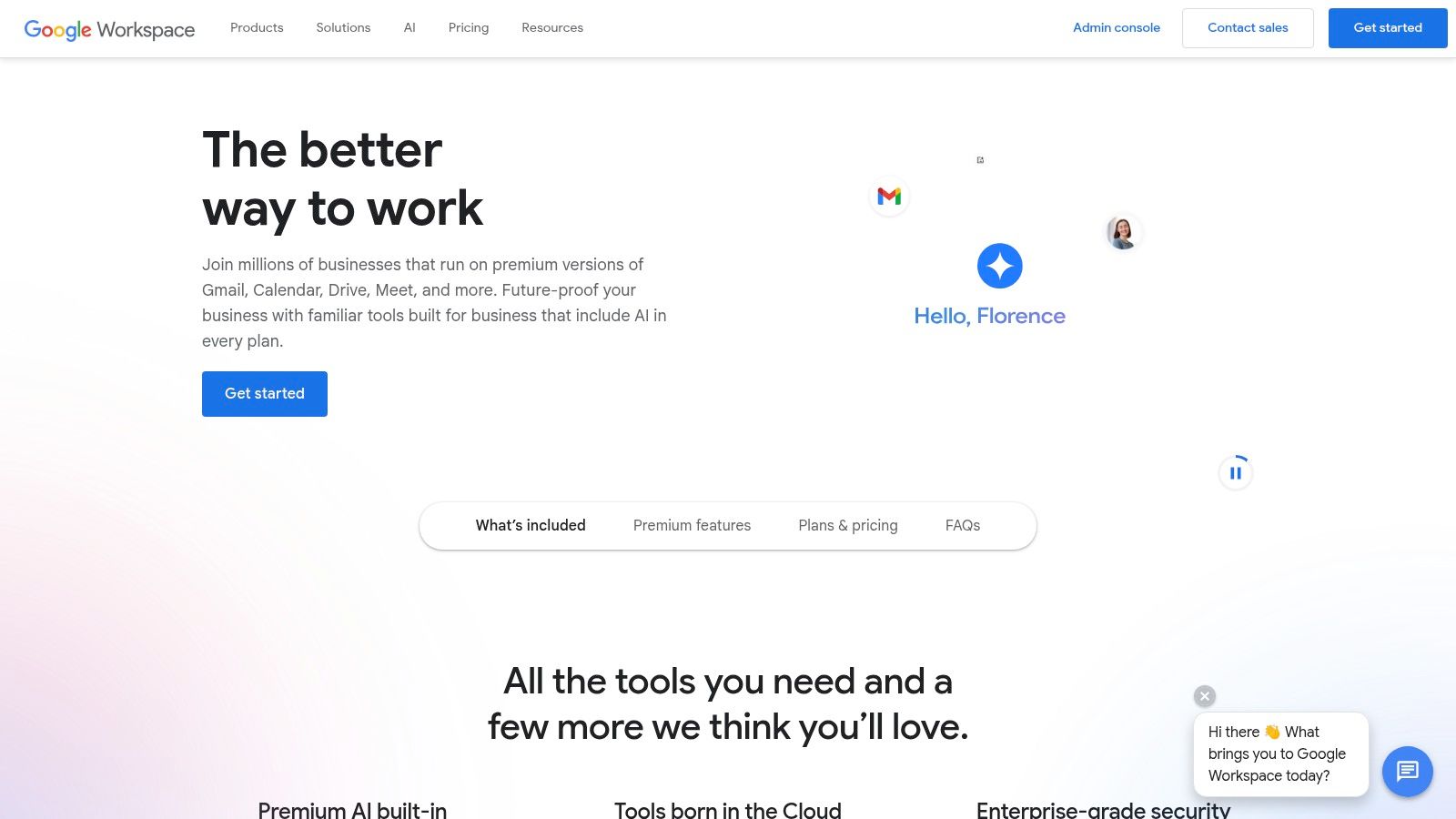
Practical Use and Implementation
In practice, a marketing team could use a Google Doc to draft a campaign brief, gather asynchronous feedback via comments, and then use Google Sheets to analyze potential ROI for different channels. The final decision can be debated and confirmed in a Google Meet call, with all relevant documents linked in the calendar invite. Implementation is straightforward since most users have prior experience with Google's tools. The key is to establish clear team conventions for file organization in Drive and communication protocols in Chat to maintain efficiency.
Key Considerations
Pros:
- Seamless collaboration with real-time co-editing and commenting.
- Accessible from any device with an internet connection.
- Strong security and compliance features on business plans.
- Extensive third-party app integrations expand functionality.
Cons:
- Advanced features are often locked behind higher-tier plans.
- Offline functionality can be limited and requires pre-emptive setup.
Pricing
Google Workspace offers multiple subscription tiers, starting with the Business Starter plan designed for small teams. Pricing scales with each tier, offering more cloud storage, enhanced security features like Vault, and advanced meeting capabilities for larger enterprises or teams with specific compliance needs.
Website: workspace.google.com
Collaborative Decision Tools Comparison
| Tool | Core Features/Characteristics | User Experience/Quality ★ | Value Proposition 💰 | Target Audience 👥 | Unique Selling Points ✨ |
|---|---|---|---|---|---|
| 🏆 Bulby | AI-powered guided brainstorming, bias overcoming, structured exercises | ★★★★☆ Intuitive & engaging | 💰 Custom pricing, contact for info | Remote & hybrid teams, startups, educators | AI-guided, research-backed, diverse thinking focus |
| Miro | Infinite canvas, 1000+ templates, real-time collaboration | ★★★★☆ User-friendly & flexible | 💰 Free & tiered plans | Agile teams, designers, broad enterprises | Extensive templates, integrations, infinite canvas |
| Asana | Task management, multiple views, automation, reporting | ★★★★☆ Easy onboarding | 💰 Freemium, advanced features paid | Project managers, teams needing workflow customization | Robust project tracking & automation |
| Trello | Kanban boards, drag-and-drop, Power-Ups, collaboration | ★★★☆☆ Simple & visual | 💰 Free & paid options | Small teams, flexible project types | Visual simplicity, easy task management |
| Monday.com | Custom workflows, multiple project views, automation | ★★★★☆ Visual & customizable | 💰 Higher pricing tiers | Diverse teams requiring workflow automation | Strong automation, visual workflows |
| Microsoft Teams | Chat, video meetings, file sharing, Office integrations | ★★★★☆ Seamless MS365 integration | 💰 Included in Microsoft 365 plans | Enterprise teams, large organizations | Integrated suite, secure, supports webinars |
| Slack | Channel messaging, file sharing, extensive integrations | ★★★★☆ User-friendly & fast | 💰 Free & paid tiers | Teams needing fast, organized communication | Powerful messaging, broad app ecosystem |
| Notion | Notes, tasks, databases, real-time collaboration | ★★★★☆ Flexible but steeper learning | 💰 Free & paid plans | Knowledge workers, small to medium teams | All-in-one workspace, highly customizable |
| Loomio | Discussion threads, proposals, voting, decision records | ★★★☆☆ Easy & transparent | 💰 Subscription-based | Consensus-focused groups, nonprofits | Structured consensus decision-making |
| Xmind | Mind maps, diagram types, templates, cross-platform | ★★★★☆ Intuitive but limited realtime | 💰 Free & premium options | Creative teams, individuals needing idea organization | Rich diagramming, creativity enhancer |
| Noni | Real-time discussion & voting, pairwise voting, structured process | ★★★★☆ Clear & engaging | 💰 Pricing not disclosed | Remote & hybrid teams needing structured decisions | Fair pairwise voting, clarity in outcomes |
| Google Workspace | Docs, Sheets, Slides, Meet, cloud storage | ★★★★☆ Seamless real-time editing | 💰 Subscription-based | All team sizes, remote & hybrid teams | Comprehensive productivity suite, real-time collaboration |
Making a Final Decision: Your Next Steps
We've journeyed through a diverse landscape of digital platforms, from the visual brainstorming power of Miro and Xmind to the structured project management of Asana and Monday.com. We explored how communication hubs like Slack and Microsoft Teams are evolving, and how specialized platforms like Loomio and Bulby offer focused solutions for consensus and evaluation. The most critical takeaway is this: there is no single "best" platform. The search for the perfect collaborative decision making tools is less about the software and more about your team's specific workflow and friction points.
Improving how your team makes choices is an active, deliberate process. A new tool won't magically fix a broken culture, but the right tool can provide the structure and clarity needed to build a better one. It acts as a catalyst, guiding your team toward more inclusive, transparent, and effective outcomes.
How to Choose the Right Tool for Your Team
Before you get drawn in by a slick interface or an impressive feature list, take a moment to diagnose your team's unique needs. An honest assessment is the foundation for making a smart choice.
Ask yourself and your team these critical questions:
- Where does our decision process break down? Do we struggle with unfocused brainstorming (consider Bulby or Miro)? Do great ideas get lost in chat threads (look at Notion or Asana integration)? Or do we lack a formal way to gain consensus and approval (Loomio is built for this)?
- What does our current tech ecosystem look like? To ensure high adoption, any new tool must integrate smoothly with your existing platforms, whether that's Google Workspace, Slack, or Microsoft Teams. A tool that creates more work by siloing information is a step backward.
- What is our team's operational style? Is your team highly autonomous and creative, thriving with the flexibility of a tool like Notion? Or do you require the rigid structure and clear reporting found in platforms like Monday.com or Asana to keep projects on track?
- What is the primary goal? Are you trying to improve strategic planning, manage daily tasks, foster asynchronous collaboration, or ensure every team member has an equal voice? Your primary objective will quickly narrow the field.
Your Actionable Next Steps
Feeling overwhelmed by the options is normal. The key is to move from analysis to action with a clear, manageable plan. Don't try to boil the ocean; instead, take small, intentional steps.
- Create a Shortlist. Based on your answers above, select just two or three collaborative decision making tools that appear to be the strongest fit. Trying to pilot more than that will lead to burnout and inconclusive results.
- Run a Pilot Program. Nearly every tool on this list offers a free trial or a capable free-forever plan. Choose a small, low-stakes project and assign a small group to test your shortlisted tools in a real-world scenario.
- Involve the Team in the Evaluation. The ultimate success of a tool depends on the people using it every day. Solicit direct feedback from your pilot group. What did they love? What frustrated them? Their buy-in is essential for successful implementation.
- Evaluate and Commit. Once the trial period is over, bring the feedback together. Compare the tools based on both hard metrics (e.g., time saved) and qualitative insights (e.g., ease of use, clarity of decisions). Make a collective choice and commit to it.
By investing this time upfront, you're not just buying a software license. You are building a stronger foundation for teamwork, innovation, and alignment for years to come.
If your diagnosis revealed that your team's biggest challenge is moving from chaotic brainstorming to clear, evidence-based choices, then your search might be over. Bulby is specifically designed to structure idea generation and evaluation, ensuring every voice is heard and the best solutions are identified through a transparent process. Start transforming your team's ideas into impactful decisions with Bulby.

